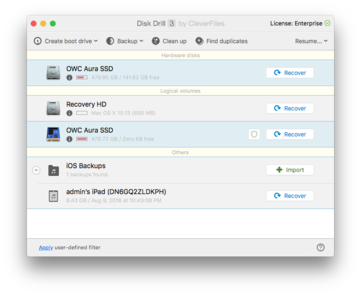
Ntfs For Mac Os X Open Source
2017.3.23 / March 23, 2017; 20 months ago ( 2017-03-23) Written in, Dual-licensed /Proprietary [ ] Website NTFS-3G is an implementation of the file system with read-write support. NTFS-3G often uses the, so it can run unmodified on many different.
Sep 22, 2015 Download NTFS-FREE for Mac OS X for free. This program allows MacOSX to access Microsoft NTFS formatted harddrives connected by USB port. A modified version of the original Linux code, this program is packaged as a easy-to-use installer so that normal users can install it.
It is runnable on,,,,,,,,,,,,,. It is licensed under either the or a proprietary license [ ]. It is a partial of and is under active maintenance and development. NTFS-3G was introduced by one of the senior Linux NTFS developers, Szabolcs Szakacsits, in July 2006. The first stable version was released on 2007-02-21 as version 1.0.
Undoubtedly it has no drawbacks and or any negative response from the user, so keep your video library upgraded with new editing tools. • DAVINCI RESOLVE 14 DAVINCI resolve is used in the film industry and TV shows because it makes your work easy and quite faster. Edit videos, audios and pictures quickly and share it on your social account like YouTube instantly. Best free video trimmer for mac. Both the pro versions are summoned up with professional as well as for home use.
The developers of NTFS-3G later formed a company,, to further develop the code. NTFS-3G is now the free 'community edition', [ ] while Tuxera NTFS is the proprietary version. Contents • • • • • • Features [ ] NTFS-3G supports all operations for writing files: files of any size can be created, modified, renamed, moved, or deleted on NTFS partitions. Is supported, as well as system-level. Support to modify and is available. NTFS partitions are using the (FUSE) interface.
According to its, NTFS-3G supports. NTFS-3G supports partial NTFS, so if an unexpected computer failure leaves the file system in an inconsistent state, the volume can be repaired. As of 2009, a volume having an unclean journal file is recovered and mounted by default. The ‘norecover’ mount option can be used to disable this behavior. Performance [ ] Benchmarks show that the driver's performance via is comparable to that of other filesystems' drivers in-kernel, provided that the CPU is powerful enough.
On embedded or old systems, the high processor usage can severely limit performance. History [ ] • NTFS-3G forked from the Linux-NTFS project on October 31, 2006.
• On February 21, 2007, Szabolcs Szakacsits announced 'the release of the first open source, freely available, stable read/write NTFS driver, NTFS-3G 1.0.' • On October 5, 2009, NTFS-3G for Mac was brought under the auspices of Ltd. And a proprietary version called Tuxera NTFS for Mac was made available.
• On April 12, 2011, it was announced that Ntfsprogs project was merged with NTFS-3G. See also [ ].
For years now, Apple has provided support for Microsoft's major drive formats—namely, FAT and NTFS. With full read and write support for FAT32, everything works well.
Until NTFS support is required. Apple's native NTFS driver handles read capability, yet write support has long been absent from the equation. Even though write support is built in to the native driver itself, it's disabled by default in OS X, since Apple doesn't officially support writing data to NTFS drives.
Though Apple supports, an alternative format also created by Microsoft to read/write OS X and Windows, the fact remains that Windows drives are formatted with NTFS by default. This fact makes it very likely that you'll need to write data to an NTFS-formatted drive from a Mac at some point or another. With this in mind, let's proceed. • On your Apple computer, connect an NFTS-formatted drive to an external port. Take note of the volume name, as you'll need it later. • Launch Terminal.app and type in the following command, entering the admin password when prompted ( Figure A).
Sudo nano /etc/fstab Figure A • This will open the fstab file that is blank by default. Now, using the volume name, enter the following command ( Figure B). LABEL=VOLUME_NAME none ntfs rw,auto,nobrowse Figure B • Press [Ctrl]+[O] to write the information to file, then press Enter to save the change ( Figure C). Figure C • Repeat steps 2-3 for each drive you wish to enable NTFS write support on, and then press [Ctrl]+[X] to close the file ( Figure D).
Figure D • Next, eject the drive(s) and mount them again. This time, you'll notice the drive does not appear in the Finder. Select Go Go to Folder. From the Finder menu, enter /Volumes, then press Enter to view the hidden volumes connected to your Mac. From here, you'll be able to drag and drop the volume(s) to the sidebar for easy access when reading and writing to/from, as it does not mount on the desktop unfortunately. To undo the edits made to the etc/fstab file, simply load the file (as in step 2) and delete the entries created for each drive, then save and exit. While this is quick and easy to implement, it's not without drawbacks, such as occasional instability, the fact that it's unsupported, and you can only enable it on a per-drive basis.